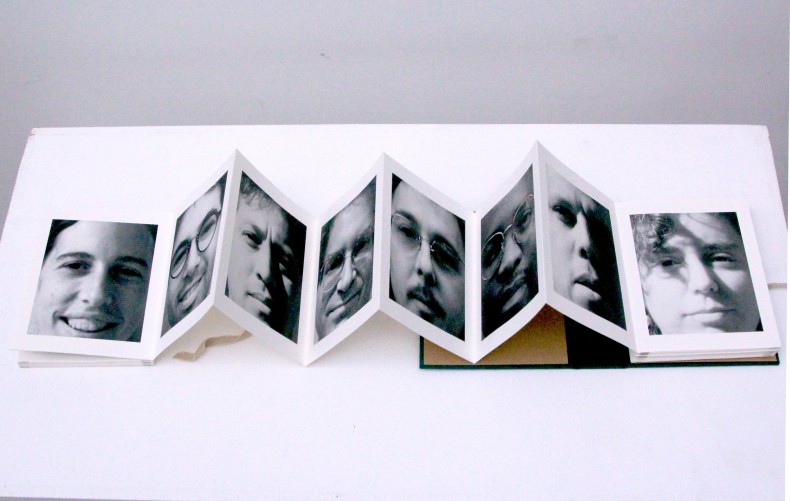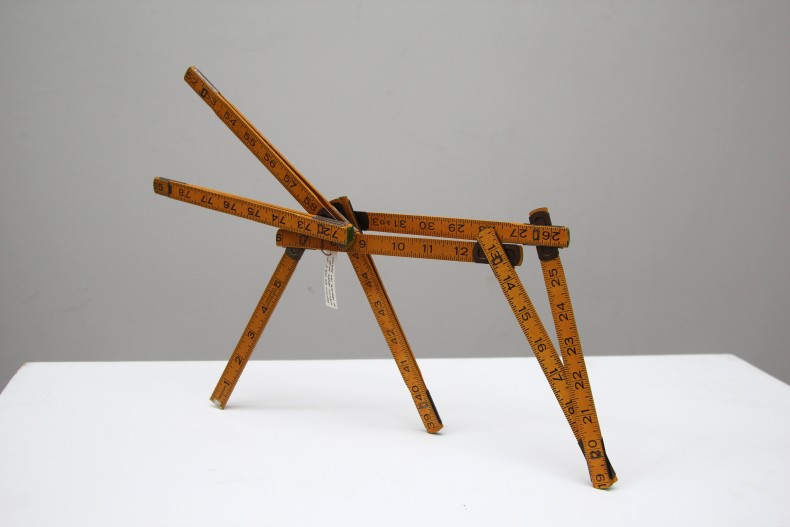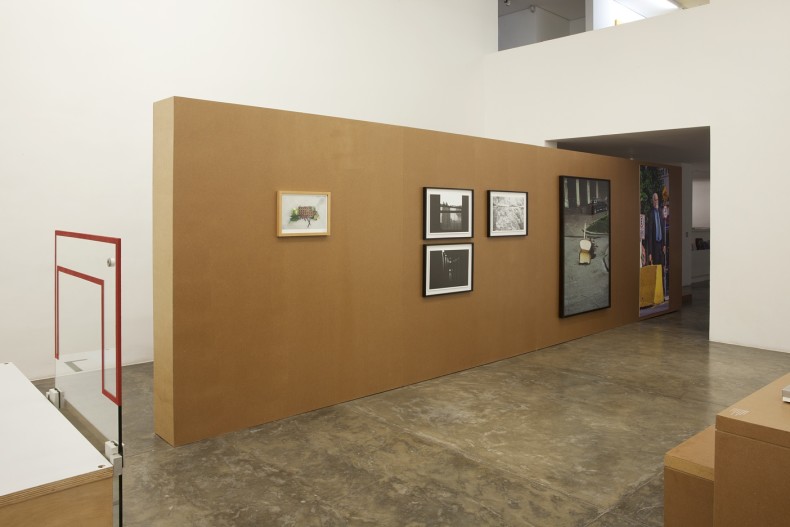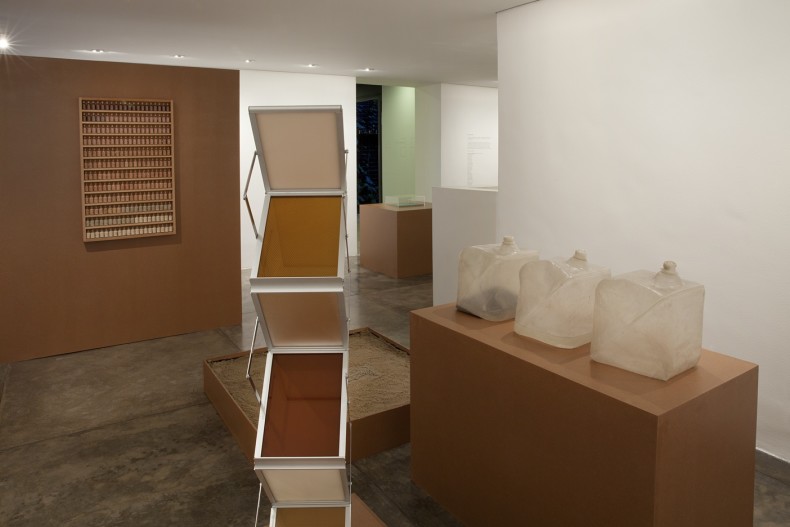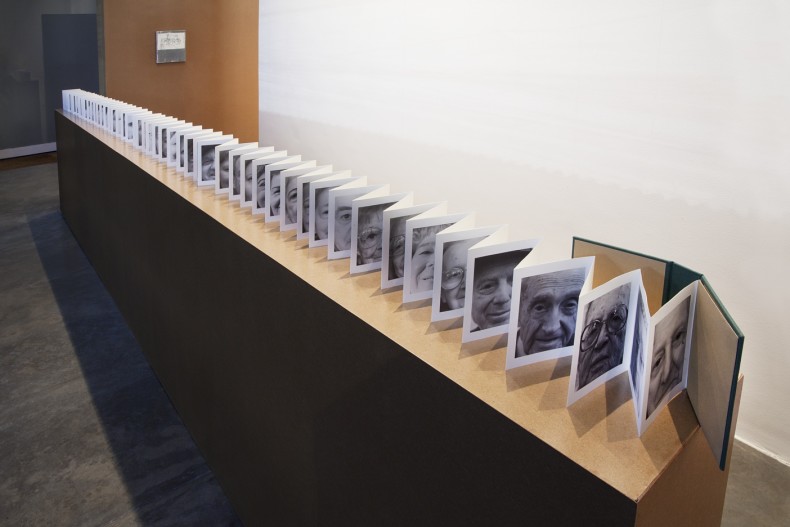Created by the gallery for our artists, the show brings together works that hone in on the poetics of their practice and, in some capacity, synthesize their works.
When approached with our proposal, the artists surprised us by responding in two opposing directions. While some traveled back, rescuing overlooked works that now, in hindsight, has proven tantamount to their current artistic research, others leapt forward, creating new pieces that signal uncharted territories, thoughts and forms to be developed.
artists and works
Abraham Palatnik is participating in the exhibition with Objeto lúdico, an interactive work from 1965/2002. Palatnik resumed his research in magnetic fields, creating a playful object, which, in the words of Frederico Morais consists of "placing geometric
shapes of different colors on a round glass base. They are set in motion by the viewer through a magnetized stick. It is important to note that Palatnik uses the positive and negative poles of the magnet to attract or repel the geometric shapes that form the fragments of a larger structure, which will be set up by the viewer-participant. It is, at the limit of interpretation, a game."
Alberto Baraya is known for his international expeditions in search of artificial "native" flora. The artist, with scientific rigor, catalogs artificial plants found in each of the countries visited, touching on issues like the rationality of science, piracy and the replica market, and local cultural habits and tastes. The Maleta pseudobotânica (2013), the instrument in which the artist suggests placing the fruit of his expeditions, is shown in a photographic reproduction in reduced dimensions - thus, portable.
The Projeto Chernobyl started by Alice Miceli in 2006, had several consequences. In addition to the well-known "autoradiographs", which record environmental contamination after long exposure of the film, the artist created photographic records of the Chernobyl exclusion zone, to be shown for the first time Prática portátil.
The concepts of extension and contraction, analogous to expansion and containment, which guide the exhibition, are present in thePantográficos series by Artur Lescher. The sculpture presented may be expanded and contracted, using its joints and hinges – physical characteristics common to the pantograph (from the Greek pantos = all + graphos = write), the articulated device capable of mechanically copying, enlarging or reducing drawings. In his sculptural practice, Lescher poses questions about the object itself and the qualities – aesthetic or conceptual – it may have in a given space, creating relations/tensions around them.
Brígida Baltar has been working with bricks since 1993. More specifically, the bricks of her house. The first results were two series of photographs showing a wall that was dug out to house the artist's body, then the bricks removed were used to build a tower. Since then, the extracted brick has been made into dust, and Brígida has started a series of new objects and designs. They limit the field of action that Brígida has developed from the beginning of her career to the end of the material, and are thus setting in time the relationship between the house and the body or the house and the universe. The house, as a universe in itself. In this exhibition, the brick powder is collected and chromatically ordered in delicate glass jars.
Bruno Dunley stated in an interview to Celeuma magazine: "I have a hard time choosing what to paint, and I think that this difficulty is somehow becoming an issue." Indecision regarding the subject is essential for Bruno Dunley's production. Borrowing the visual archive of the encyclopedia, the artist renders the scientific and the schematic with the imprecision of the stroke and the pigment, creating paintings that are between figurative and abstract, ranging between objectivity and subjectivity.
Cao Guimarães exhibits a photograph in series Gambiarras, in which the ability for improvisation creates estrangements capable of reinventing the look for prosaic objects and situations, creating a singular poetry. In the work selected for Prática portátil, a trunk remains provisionally open thanks to a wooden plank.
The way Carlito Carvalhosa activates space is simultaneously an act of concealment and revelation. Summoning and frustrating the viewer's gaze, the Vai para fora cá dentro model, by Carlito Carvalhosa, is covered with viewfinders which, although instigating, only allow partial or obstructed views of its interior space – points of view predetermined by the artist.
The painting by Cristina Canale shows unique characteristics, especially the way figurative elements of the composition are always ready to fade into pure abstraction. The piece Ladrilho, designed especially for the exhibition, brings tiles to mind, due to the colors traditionally employed in making them (blue and white), the repetition of a pattern, and, also, the very shape of the painting – a square in small dimensions.
Eduardo Coimbra presents a rereading of Malas com movimento respiratório (1992). The works, produced in the 1990s, make use of electric mechanisms, lighting and engines applied to everyday objects. Pointing to the landscaping and architectural surrealism that permeates his later practice, the artist views bags as chests, a space which, with its opening and closing motion, controls the entry and containment of air. The hairy bags left on the floor, breathing deeply, cause estrangement both due to the space in which they are and to the perception of the viewer.
Fábio Miguez explores the pictorial space beyond the painting in Ping pong. A large wooden box encloses different surfaces (in sizes and materials) with geometric motifs that unfold into three dimensions – despite being two-dimensional spaces (flat), which could traditionally be displayed on the walls, making the container into a new object of complex categorization.
Standing out are historical works like Bólides Apropriações, by Hélio Oiticica, echoing the events of North American land art and environmental art, although the artist saw them in a different manner: "Bólides with earth inside, is much more modern now than earth works, as it is a piece of land. (...) All this mythologizing is synthesized in something other than this picture or sculpture, it is a piece of the thing," said the artist in a conversation with Aracy Amaral, in 1977, reproduced in book Textos do trópico de Capricórnio, (vol.1).
Early in her career, Karin Lambrecht rethinks the canvas and how to paint – eliminating the body, she stitches the fabric, using cuttings. Her intimate and autobiographical works often include crosses and references to the body, noble metals, and indices of different levels of viewer identification with the work. The selected work, Uma porta para o perdão, is an object of mixed techniques, summarizing Karin's iconography and hiding handwritten tickets that require the visitor find and open them to be able to read them.
Caixa pó, by Laura Vinci, is essentially a box full of marble dust. Inside the box, a metal stamp whose outline states "dust" is maintained as an invitation to play, alluding to our human tendency to create outlines, to transform matter into sense through language. This is particularly poignant due to the use of marble, the morphological material of excellence in the Ancient Greek tradition of sculpture and in the history of Roman art.
For nearly two decades Lucia Koch has research questions of space and lighting (lights, shades and color filters) in dialogue with architecture. The artist participates in the exhibition with Mel and with an unprecedented untitled work. Incarcerated in a suitcase and in prefabricated window structures, respectively, the overlay of colored acrylic sheets expand through hinges, revealing Lucia's poetics. Easily confused with home building materials, they synthesize issues of light and space present in site-specific installations like Conversion, displayed prominently in the Sharjah Biennial (2013).
Stockage 01, by Luzia Simons, can be understood as a preliminary stage, which unfolded the artist's current research (with scannograms in large format). Luzia has the tulip, which became one of the vanitasmotifs after the collapse of the Dutch market in February 1637 (tulipomania was the first speculative bubble in history), as her central object. The artist builds a bridge – from the XVII century to the present time – with issues typical of our time, such as globalization, cultural nomadism and multicultural brands.
Combinação Torreão, defined as a kind of tower, pavilion or roof, is the title of the ongoing work by Marcelo Silveira. Sheltered inside a case, the work consists of a cubic tangle design made out of leather from Pernambuco. In full expansion, the work covers about 9 m2. As an open network, which appropriates the space in which it expands, the work suggests physical proximity and symbolic distance between numerous works of art and institutions, including local crafts and the art market. In this exhibition, Combinação Torreão (2004/2014) appears closed, with a photograph illustrating its full scalability.
Marco Maggi often deals with reflections and transparency by using mirrors and incisions on acrylic and transparent materials. The work presented at Galeria Nara Roesler, called Portable infinite (New Dog) is a mirror for vehicle inspection that can be handled by the visitor. Parallel to the ground, the mirror reflects the ceiling or the sky, making us rethink the zenith.
Marcos Chaves' production is part, in renewed manner, of the long tradition of visual poetry, either by inserting phrases, or by the choice of subtly ambiguous and entertaining titles, leading to a humorous reflection – as is the case with Jaws.The title leads to a new perception of the gaping red bag. Jaws is also the original English title of the classic blockbuster movie, bringing a pop statement that is recurrent in his work.
Filmed in Lima, Bulto, by Melanie Smith, tells the story of the pilgrimage of a bulky pink "thingamajig". The object does not denounce itself and you cannot recognize its use or purpose – is shown itself only as a mass that disrupts, interrupts and stops the flow of narration of the film and the political, historical and social implications within the narrative.
Critic Michael Asbury comments that Milton Machado is a "storyteller." Written text is often important in works and originates characters and parallel worlds. The title of the works, as well as the artist's comments on them, is essential to understanding – or to the confusion of meaning – of his work. Pano de limpeza could simply be a flannel for cleaning electronics devices, a present by Brazilian brand Gradiente. Interventions and cutouts, however, changed the word, making it "radiante" (radiant) – the result of all that is properly cleaned.
The pair of artists O Grivo participates in the exhibition with Máquinas sonoras. With humorous and seemingly precarious contraptions, O Grivo belongs to the select group of Brazilian audio-visual artists who are well placed in the context of the visual arts and whose works include the use of unusual devices. Unlike these, however, thanks in part to the musical education of its members, O Grivo works prioritize sound: although the visual effect is far from casual, the image is a result of the musical dimension.
Paul Ramirez Jonas actually considers his creations reinventions, mainly derived from the notion of reading – an understanding that considers the public much more than a passive reader, but an agent capable of building the meaning of the work through his participation. Work 100, of 1995, shows, in chronological order, black and white pictures of one hundred people from 0 to 99 years of age. The result is a rather simple timeline in which the visitor intuitively inserts himself.
Often exploring language, Paulo Bruscky makes use of paronomasia to reframe a piece of gelo baiano (a concrete block used to close streets) by simply fixing a handle on top of the concrete block. A photograph witnesses the artist's action, dressed as a "businessman", carrying his case. Always testing the limits of artistic practice, he remains consistently outside the market, appropriating the streets of Recife as support for his performances and developing work, often ephemeral likeMala de gelo [Ice suitcase], a performative object that will melt during opening of the exhibition.
Raul Mourão has a long series of works about soccer. He started drawing the geometry of soccer fields in iron and, in more recent works, created pieces from the perspective of the penalty, breaking the penalty area into multiple portions. Pênalti caixa, which encloses a large area in the soccer field, tests the fittings and boundaries between what is inside and what is outside, between what is static and what is movement.
The drawings in shades of red and magenta that permeate the work of Rodolpho Parigi are based on the automatistic methods of Surrealism and were recognized in their large formats. In his new series, the artist manages to transfer his design – visceral and organic, cut up, idiosyncratic in all references from high art to pop – onto paper, in small dimensions.
Sérgio Sister displays small format paintings, created in 2003, which address his small canvases developed since 1988. Rodrigo Naves considers that the work by Sister, despite delving into specific issues of the painting without any concession to prosaic comments, such as light, tone and nature of the brushstrokes, contains internal tensions and conflicts that take disquiet beyond strictly pictorial themes. "It is above all in these indefinite moments that the paintings appear more intensely," says the critic and curator.
Relicário: mala de mármore is no exception to the wit of Vik Muniz. The combination of the material and subject matter – a bag made of solid black marble – confuses the modus apparatus of the viewer and frustrates expectations. Part of the series Relicário, not as well-known as many others, this work refers to his earlier production, created in the 1980s, including Ashanti Joystick and Clown Skull.
Virginia Medeiros displays a wooden mockup of the Kombi of the 1960s used in the trips of project Fala dos Confins. With the van, named Catarina, the artist traveled through cities in the northeastern hinterland and originated a sensitive meeting between the oral tradition of the hinterland inhabitants and the universe of contemporary visual arts. The work demonstrates the artist's constant research for lifestyles.
